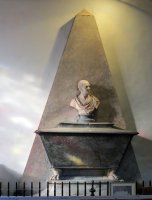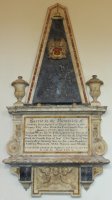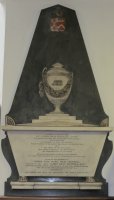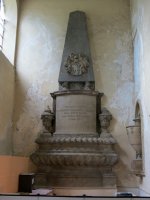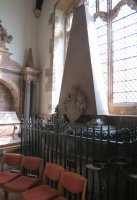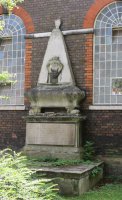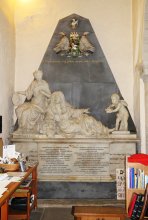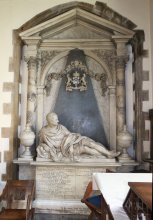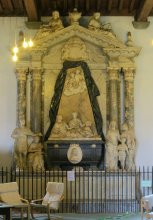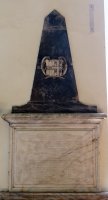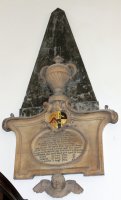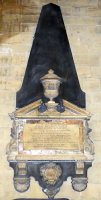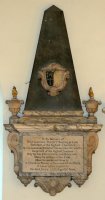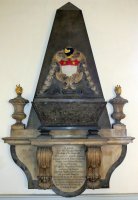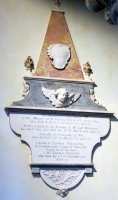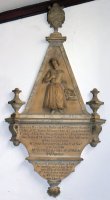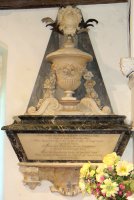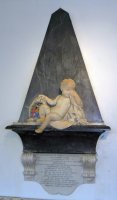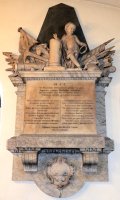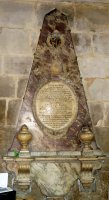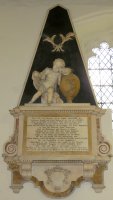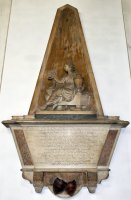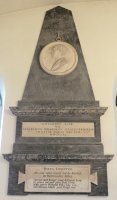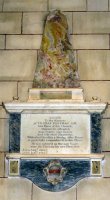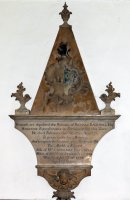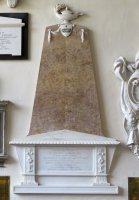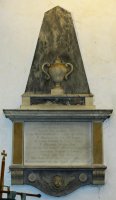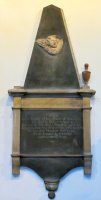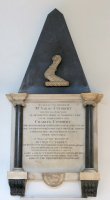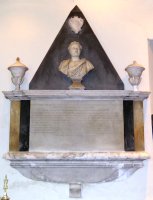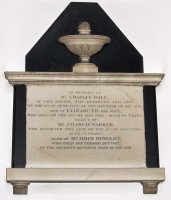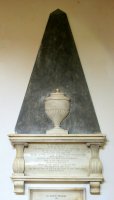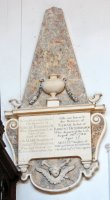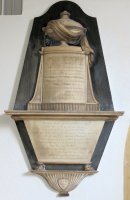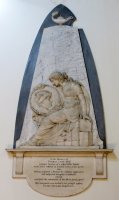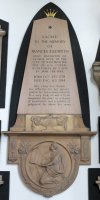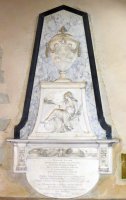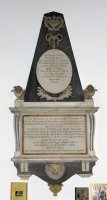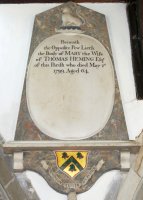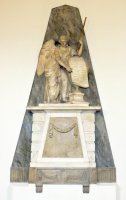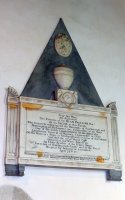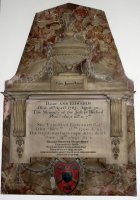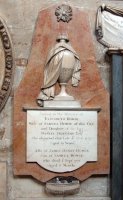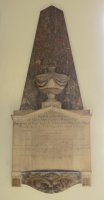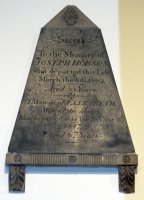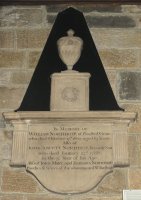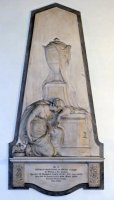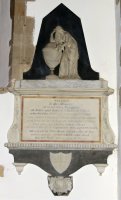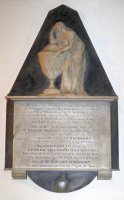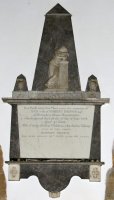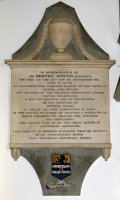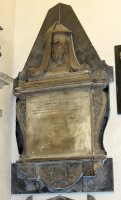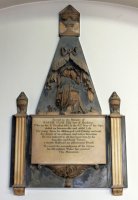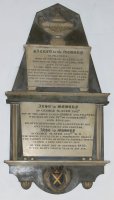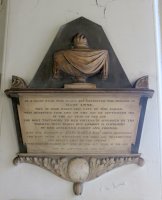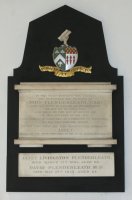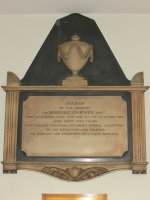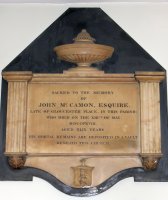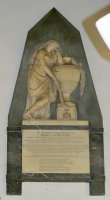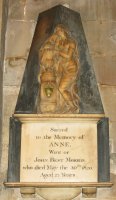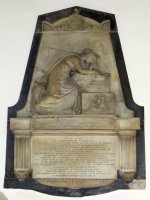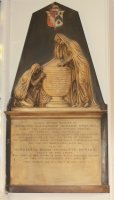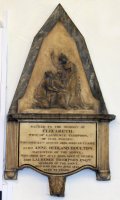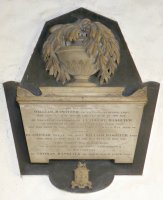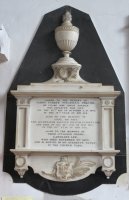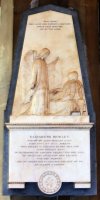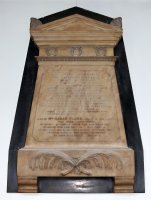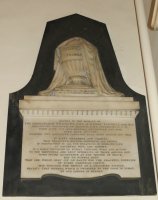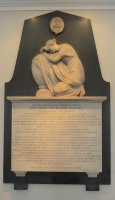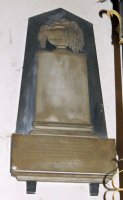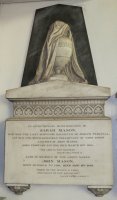Obelisk monuments in the Church
From the early 18th Century, obelisk monuments appeared in the church as a tall, impressive alternative to the conventional rectangular style. This page looks at a wide range of examples of the genre over the next 120 years or so, including different shapes of obelisk, and the sculpture upon them.
What is an obelisk monument, rationale
Obelisk monuments appeared early in the 18th Century, became more frequent with each successive decade, and achieved their greatest popularity from around the 1760s. By obelisk here, is meant a slab of marble, cut with steeply slanting sides, and typically the very top with shallower slant. Such an obelisk is still far wider in proportion than an Egyptian, 3D obelisk, as are found out of doors in the churchyard. They are occasionally called pyramid monuments, but are much too steep-sided for that.
Regardless, adding an obelisk was an easy way of making a conventional panel monument larger and more grand, and provides a field on which relief sculpture can be placed. Many obelisk monuments are basically a conventional rectangular panel with the obelisk simply added on top - the monument would look complete without the obelisk. Others have a slanted casket shape below the obelisk, and others still aim for a more integrated whole, with the lower part slanting inwards and down to balance the obelisk above. But quite early in the genre, we have the standard elements of these monuments as a taller obelisk at the top, typically in black or dark marble, though there are a good number of pale obelisks a central shelf, projecting forward and going the full width of the monument, and a lower portion, generally less tall than the obelisk, and sometimes a bit wider. The obelisk portion often contains decorative sculpture, and the lower portion contains the inscription. The obelisk is tall enough to allow some sculptural element taller than would look proportionate were the obelisk not there, up to and including a portrait bust or figure sculpture, or could have two layers, say a lower funereal urn, and an upper coat of arms or wreath. The lower portion, usually with the inscription, is generally plainer, but does offer opportunity for decoration if desired - the sides of the frame as flattened pillars or pilasters, carved brackets supporting the lower shelf under the inscribed panel, and the space between them often occupied by a little panel called an apron. Sometimes, that apron is extended, to become a third portion to the monument in its own right.
Grander obelisk monuments
Grand obelisk-and-sarcophagus monuments.
Before surveying the smaller obelisk monuments, we must note that a few of the 18th Century ones were great masses of marble on the grandest scale. Here we have the John Fellowes, Baronet obelisk monument in Carshalton, which must be near the top in terms of tonnage of marble: the obelisk stands on lionheads on a plinth bearing the inscription, itself on a great sarcophagus - the whole construction being several times the height of a man. Next, the Lady Mary Whichcote monument in Chesham, again an obelisk above a sarcophagus, here, very rare indeed, being flat but free-standing. And another of similar composition, but with here the obelisk on top of a sarcophagus on top of the inscribed plinth, and the monument being on the exterior of the church. All three have the coat of arms of the deceased on the obelisk itself. As ever on this website, click on any picture to enlarge to see full detail, or hover for more info.
Grand figure sculpture monuments, with obelisks.
Also among the grand pieces are those with figure sculpture, where the main feature is the sculpture and a obelisk forms part of the backdrop. Here we see the sculptor Henry Cheere's monument to Robert Raymond in Abbots Langley Church, Earl Paget's monument in Hillingdon, and grandest of all, the Earl of Shelburne monument by the sculptor Peter Scheemakers. All these have reclining figures in front of the obelisk, which stands as a memento mori because of the Egyptian connotation.
So, let us look now at the full range of smaller obelisk monuments, taking examples in more or less chronological sequence from their inception early in the 18th Century through to the 1840s when they more or less disappeared, and looking to illustrate both the typical obelisks and the variety of less usual types.
Early 18th Century obelisk monuments
Here are some early examples. A transition from a different style is our first example, the Henry Penton monument in St James Clerkenwell, about as early as I have seen: he died in 1714. We see a thin obelisk, the prominent shelf on which it sits, dividing it from the inscribed panel, another shelf, and then quite a deep third, base or apron portion. The little pillar capital at the top, and the covering of the obelisk with low relief carving, are not something widely taken up in the genre thereafter, but the addition of little pots, here shaped as flaming shells, to the sides of the obelisk, and the scrolly side-pieces to the inscription, and the carved brackets, are all quite frequently used elements.
Early obelisk monuments.
The next two are 1720s examples, showing the type of obelisk which became most usual, and a more triangular type which was on the whole less popular. The carved shield of arms on the one, and the half-pot on the other, are usual devices throughout the period these monuments were made.
18th Century from 1730
1730s obelisk monuments.
Here are three 1730s examples, all with rather similarly angled black obelisks. That to the left could just as easily have been a conventional rectangular panel with pediment and pot, but how much less impressive without the extra height. The other two both have a shield of arms in a cartouche on the obelisk, and that to the right has a casket tomb too; both have flaming urns to the sides. The three show a nice variety of treatments to the lower portion with the inscription, with curly side-pieces, carved brackets, and other decorative ornament.
1740s: colours and exotic shapes.
1740s now. The monument to Thomas Treslove is an example of an obelisk monument in different coloured marbles, which was a way to add further richness to a monument, used up until the Napoleonic wars cut off the supply of coloured marbles at the very end of the 18th Century. With light, decorative sculptural elements including a winged cherub head. Then a brownish, more solid piece with a solid little female figure: like the previous one, this tapers towards the base, and includes pots to the sides. Then the John Gurnell monument, with the obelisk on a casket, and covered with a large garlanded pot, curly pediment, and shield of arms with mantling, once again in different coloured marbles for striking effect.
Obelisk monuments with figure sculpture, 1750s.
And three figure pieces, these from the 1750s, all by significant sculptors. The weeping, seated cherub in front of a dark obelisk is by Thomas Adye, the obelisk giving excellent proportions to the monument as a whole. Then an early example of a stubby obelisk, a type rare at this time but which became frequently used later on. With standing cherub, pillar and large trophy of weaponry and nautical accoutrements, the obelisk is there simply to provide a backing taller than a pediment. Rysbrack was the sculptor. And third, the tall monument with casket and fine carving of a woman and pot, by Westmacott the Elder (see this page) - the obelisk is very tall here, giving a convincedly vertical monument of large size - at one time there would have been a coat of arms near the top.
Series from 1761.
By the 1760s, we are at the peak of variety, and here are several pieces all from 1761. The first two, to Bishop Ellys and Revd Spateman, get their impact from the colourful marbles used; the third, to Thomas Holmes, has figure sculpture too: the excellent James Paty was the sculptor of this piece. And to the right, two with black obelisks from the same year. The first with a snuffling cherub, and the second being to the eminent Alexander Pope, with a portrait medallion on the obelisk, this being by the interesting sculptor Prince Hoare of Bath.
Contrasting obelisk monuments, 1760s.
Two later examples from the 1760s. The one to the left, to Richard Backwell MP, by the stonemason William Cox, another coloured one, is about as pyramidal an obelisk as we can get. The one to the right, to Sir Gerrard Bennet, Baronet, in Wheathamstead, has the broadest of obelisks, but the point I want to make is that by the contrasting colours, this piece exemplifies those where the lower part with the inscription stands alone, and could have been a short casket monument. rather than a tall obelisk monument.
1760s: different heights of obelisks.
This group from the 1770s exemplifies the range of heights of obelisks compared to the rest of the monuments of which they form a part. The two to the left are typically tall ones, with the obelisk over half the total height of the monument, even though the width is a little less than the lower inscribed portion. Next, the Sarah Cuthbert panel has roughly equal proportions to upper and lower part, with a broader obelisk base to its height. Peter Leheup's monument, with a fine bust, in Morden Church, has an equilateral triangle as the obelisk, completely pointed, so pyramidal would be a fair term here. And the Charles Dale panel from the end of the decade, in St Magnus the Martyr in the City of London, exemplifies a very squat obelisk which is a type found with greater frequency in the 19th Century.
Obelisk monuments with pots carved in high relief.
The 1780s and 1790s were perhaps the time when obelisk monuments were most widely produced, and we can use them to show more of the range of types. First a group showing obelisks with pots, or funereal urns, carved upon them. The Josias Du Pre monument in Beaconsfield is sombre and classical, white on black, contrasting with the more decorative and light Rushbrook panel, with the same proportions to the obelisk. The Isaac Bauch monument has a wavy top to the obelisk. And the monument to Coulson Skottowe in Chesham has a single large, egg-shaped pot taking up most of the broad obelisk, while still allowing for a small shield of arms above.
Obelisk monuments with figures, by John Bacon Sr.
Some figure examples, all by the excellent sculptor John Bacon Senior, who had a penchant for obelisk monuments. By adding a tall plinth, most of the height of the obelisk can be used, as in the monument to Charles Foulis, in St Mary Woodford, above left. The next two with the obelisk in front of a gently curved black backing, each with a carving of a girl in high relief, but in different portions of the monument. To the right is another example by Bacon: the Fysh De Burgh monument in West Drayton, with much carving both on and off the obelisk, and an outer black border to it.
Variations on the obelisk, 1780s-1790s
Placing an inscribed panel on the obelisk is an option less common earlier on, and if it is to be done, an oval is more harmonious than a rectangle, as in the example above left, in St Peter in Thanet, Kent. The Heming monument next above shows the size of the oval taken to an extreme, decidedly less pleasing to the eye, though the obelisk in grey and black and red and white marble is arresting enough. The monument by sculptor John Hickey in Leyton Parish Church has the obelisk take up the whole height of the monument, though there is still a dividing horizontal shelf. And to the right, the Hugh Palliser monument in Chalfont returns to the pyramid style.
Coloured marble obelisks.
Finally with the 1780s and 1790s, these decades saw the last of coloured marble monuments for a while, and here are three examples of those. A very short obelisk in Ealing, with super brecciated (marble with broken inclusions) to the left. A dark and pale rather tall obelisk in Aston, Birmingham, with the inscription nn an oval within rather than below the obelisk next. And then one to Elizabeth Howse, in Bath Abbey, with the obelisk and lower part cut as a single piece of red marble.
19th Century Obelisk monuments
Typical 1800s obelisk monuments.
Colour is out and white-on-black monuments are becoming the rule now, with the occasional all-white one. Here are some typical 1800s examples. Above left, tall, dark obelisks with white lower portions in Richmond Church and Bradford Cathedral, these examples both being from 1801, and the first still with some colour. Above centre, an obelisk with no lower portion, this being to Joseph Hobson, in St Bartholomew's Church, Wednesbury. And to the right, two short obelisk examples, that to the far right being by John Bacon Junior.
Girls with marble pots, 1800s.
You can never have too many carved girls with marble pots, and we have already seen several examples of these with obelisk monuments. Again from the 1800s, some further examples. Above left, a charming example in Twickenham, again by John Bacon Junior, with the curved lines of the draped figure nicely setting off the diagonals of the obelisk. The short-obelisk monument to Susannah Gray has the girl leaning on the pot - this is 1800 and still has a bit of included coloured marble - and a piece with the identical composition is a panel signed by Robert Blore in Bedfont, above right - did he see the earlier piece in Kent and copy it?. The final example above far right, of the 1810s, has a girl embracing a pot on a pillar, and the obelisk, unusually, has mini-obelisks to the sides.
Variety of 1810s obelisk monuments.
Some 1810s examples, showing a range of shapes to the obelisk. Above left, an example in West Ham to Baronet Hervey Smyth, so short an obelisk and with curved sides, that it is scarce an obelisk at all - note the almost symmetrical base. Then an example in St Helen Bishopsgate, where the obelisk, despite the shelf in the middle, is simply part of the overall shape of the backing rather than a distinct feature in its own right. The Ralph Clay monument, with a carving of a dying tree and canopy over a draped pot, and small structures to the side of the obelisk, is in St Katherine Cree, and was made by the statuary Sherwood of Derby. And in Margate, the monument to Frances Slater, with the broad obelisk largely covered by a rectangular inscribed panel with a small pot upon it.
Short obelisk monuments, 1810s.
While there are still tall obelisks, there are more examples of short, broad ones from this decade. Here are some London examples, including two by New Road statuaries Randall and Whitelaw, a very broad obelisk to John Plenderleath, and a very angular pyramid to John McCamon in St Marylebone.
1820s female figure sculpture.
Here are some examples of 1820s female figure sculpture. Above left, two standing girls with pots, both on tall, broad obelisks and making full use of the space, in Enfield and Wolverhampton respectively. Then in the middle, a stubby obelisk with a seated, bowed forward girl by no less than the sculptor Francis Chantrey, this one being in Walton on Thames Church. And to the right, two examples with more than one figure, that to the right having a border to the obelisk.
1830s, decline of the obelisk.
By the 1830s, we are coming towards the end of the obelisk monument genre, and some of the examples from that decade have the obelisk cut as part of the backing panel for the whole monument and with the clear dividing line between obelisk above and inscribed panel below blurred or lost. Above left, a piece by statue J. Browne, in Hornchurch; next, a backing-panel obelisk, then a more conventional one with upper and lower part with figure sculpture to Elizabeth Morley, the obelisk being very broad, and an obelisk shape behind a tapered panel in St James Clerkenwell.
Late examples of obelisk monuments.
This pattern of less distinctive obelisks continues into the 1840s, and those few obelisks of later date than that. Above are a few examples of these later pieces (hover for more information or click any picture to enlarge). The one in the centre sums up the trend: while containing a fine carving of a girl composed in an almost circular composition within the broad obelisk, that obelisk itself has come just part of the overall shape of the monument.
See also: kneeler monuments // white-on-black monuments // Classical girls on monuments // winged cherub heads // skulls
Visits to this page: 2,886 since 9 May 2022

